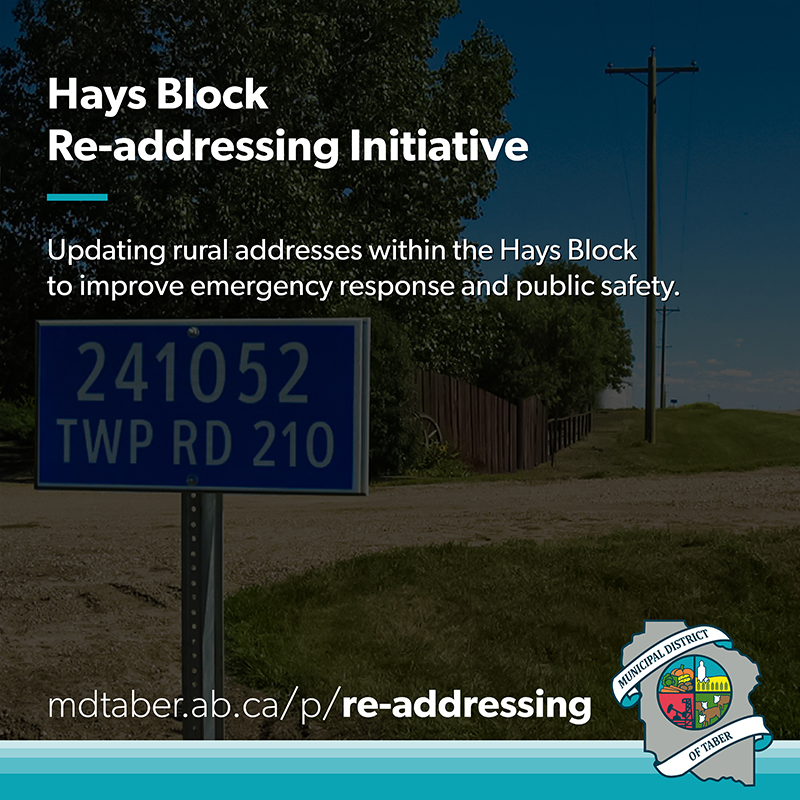As the vibrant colours of fall sweep through the landscape, it's an ideal time to focus on essential tree care. Proper fall maintenance helps prepare trees for winter's harsh conditions and supports their health and resilience year-round. By taking steps to protect roots, manage moisture, and address potential issues now, you can ensure that your trees remain strong and vibrant into the next growing season. Fall tree care not only preserves the beauty of your landscape but also promotes long-term vitality and growth for your trees.
| Questions? |
|---|
| Call 403-223-8735 Monday - Friday 8:00 am - 4:30 pm |
Expand the blue (+) tabs below to learn more.
Fall Tree Watering
As trees prepare for winter, deep watering can significantly benefit their health throughout the cold months and into early spring. Alberta often experiences dry conditions with minimal moisture during September and October, leaving many trees susceptible to water deficiency during these critical months.
Watering in the fall serves an essential purpose: water acts as an insulator, protecting the soil and, most importantly, the tree’s roots. When cold air reaches a dry root system, it can lead to root damage or even death, which may result in branch dieback or the eventual loss of the tree.
When water is present, frozen soil stays warmer than the surrounding cold air, offering crucial protection. Roots surrounded by dry soil are at greater risk of damage from cold, dry air, which can “draw” water from the roots and form ice crystals within root cells, potentially damaging or killing fine roots. This stress is particularly severe for newly planted trees, which are more vulnerable to winter injury than mature trees.
Coniferous trees, in particular, may experience water loss through their needles faster than their roots can replenish it. This can lead to “winter browning,” where needles turn brown by spring due to dehydration.
To prevent branch dieback or tree loss, ensure trees have an adequate water supply in the fall, which is vital for their survival during harsh winter conditions.
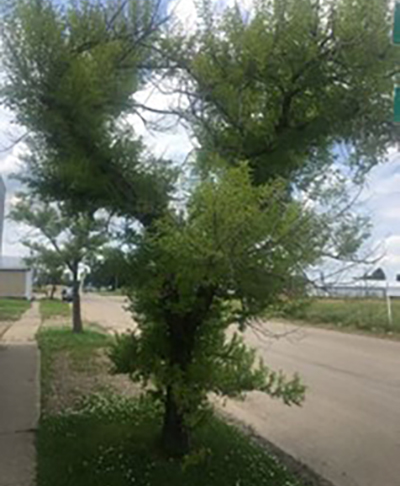 Epicormic shoots due to winterkill Epicormic shoots due to winterkill | 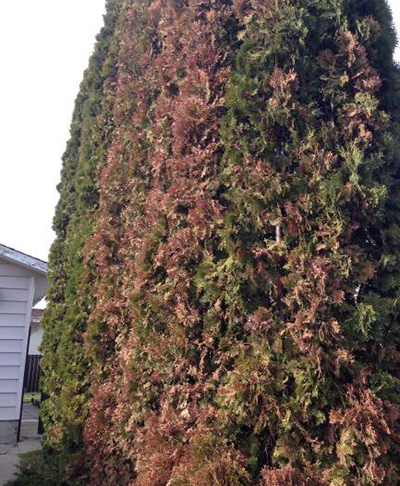 Winterkill on cedar Winterkill on cedar | 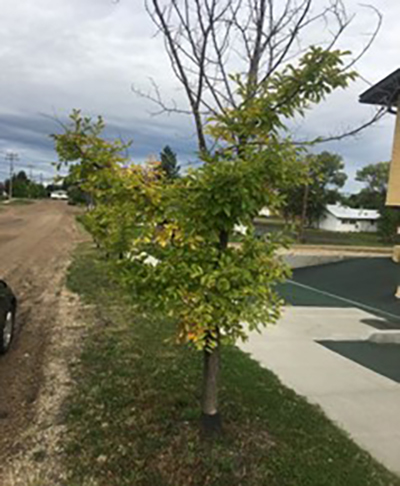 90% winterkill 90% winterkill |
Steps for fall watering
1. Water and Soil Testing for Sodium
Before beginning any fall watering, it’s essential to check the sodium levels in both water and soil. High sodium levels can be harmful to trees over time. Water and soil-testing laboratories can measure sodium as well as other key elements like calcium, iron, magnesium, and total dissolved solids (TDS) or electrical conductivity (EC).
- Soil Testing: Measure soil salinity by assessing its electrical conductivity (ECe) in deciSiemens per meter (dS/m). Trees generally thrive in soils with an ECe up to 4 dS/m; higher levels may restrict growth, and only salt-tolerant species can survive in soils with an ECe between 8-16 dS/m.
- Water Testing: Sodium content in water should also be checked, as watering with high-sodium water increases soil salinity over time. Most plants, including trees, struggle when sodium levels exceed 100 ppm. Salt-affected trees may show stunted growth and may eventually succumb to high salt concentrations in the soil or on the trees themselves.
2. Timing
Timing fall watering can be challenging due to Alberta’s unpredictable weather. For hardwood species, water after leaves have fallen but before the first soil freeze. Coniferous trees follow a similar timing. In Alberta, most trees begin to shut down in early October, shortly before the soil freezes. Watering should take place early in the day, allowing plants to absorb water before nighttime temperatures drop.
3. Where to Water
A common mistake is watering directly near the trunk. Instead, water around the tree’s “drip line”—the area extending from the outermost branch tips straight down to the ground. Roots spread beyond this line, often extending to the tree’s height, and this is where water is most effectively absorbed.
4. How Much to Water
As a general rule, apply 10 gallons of water per inch of the tree's diameter measured at breast height. Water should be applied slowly and deeply, reaching 6-12 inches into the soil. Deep-root forks or needles, soaker hoses, or sprinklers are effective for deep watering. If using sprinklers, avoid spraying needles or foliage and keep water away from the trunk.
5. Mulching
Applying mulch before freezing helps insulate roots, reduces freeze damage, and supports overall tree health. Mulch also prevents weeds, protects roots from extreme temperatures, and retains moisture. Create a donut-shaped mulch ring around the tree, ensuring it doesn't touch the trunk to avoid attracting pests and disease.
By following these steps, you can help ensure your trees are well-prepared to endure Alberta’s harsh winter months.
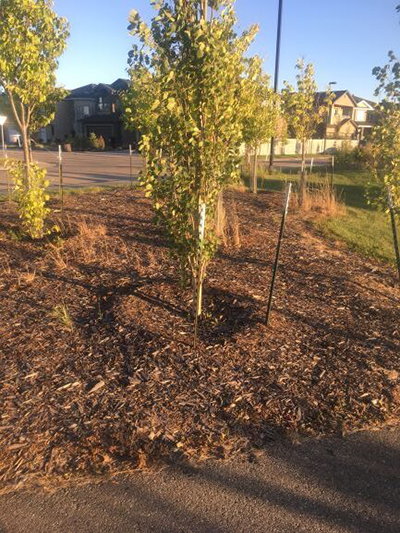 | 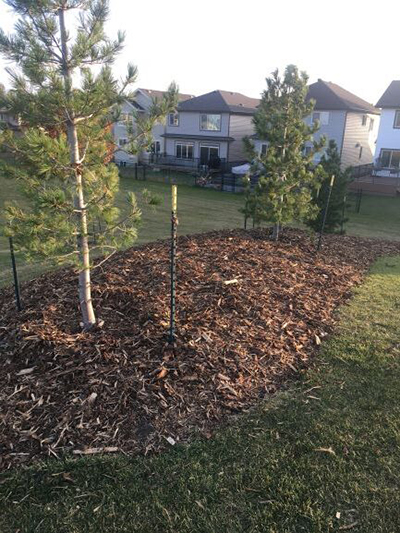 | 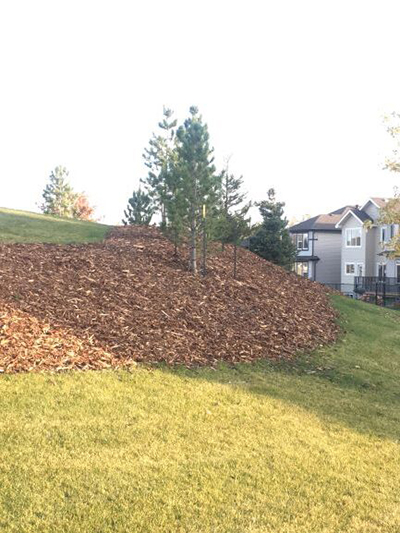 |
Seasonal/Fall Needle Drop
As fall brings vibrant leaf colors from hardwood trees, a natural phenomenon known as fall needle drop occurs in pine, spruce, fir, and arborvitae species. During this season, these trees shed their older needles, creating space for new growth and promoting overall health and vitality. This shedding process is an essential part of the tree’s life cycle, helping it adapt to changing environmental conditions and maintain long-term resilience.
Symptoms and Identification
Depending on each coniferous species, older needles stay on a tree different time length. Pines will usually keep their needles for 4-8 years. Spruces typically keep their needles longer than pines do, generally for 5-10 years. Arborvitae sheds branchlets as they age yet remain on the tree for quite some time before falling. The fall needle drop(yellowing of needles) occurs uniformly across the entire tree, from its uppermost branches to the lower ones. As autumn approaches, the older needles on the inside of the tree canopy and closer to the tree trunk will transition from their usual green to hues of yellow, brown, or reddish-tan. Younger needles remain green, healthy, and vigorous with healthy apical buds.
It is very important to differentiate between fall needle drop and other tree health issues. Any irregularity, such as abnormal branch die-off or an uneven pattern of needle shedding, indicates a deviation from the normal fall needle drop process. In such cases, further investigation is warranted to identify the underlying issue that the tree may be suffering from a more serious disease or insect problem.
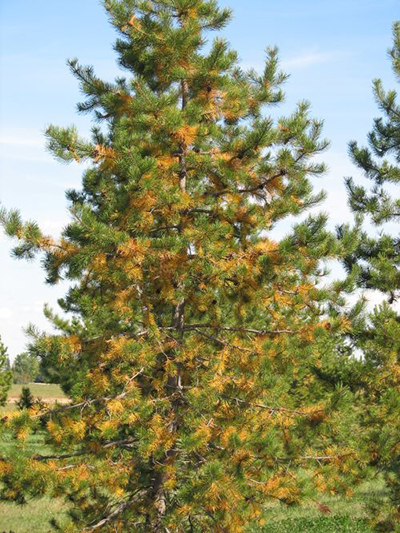 Uniformity Uniformity | 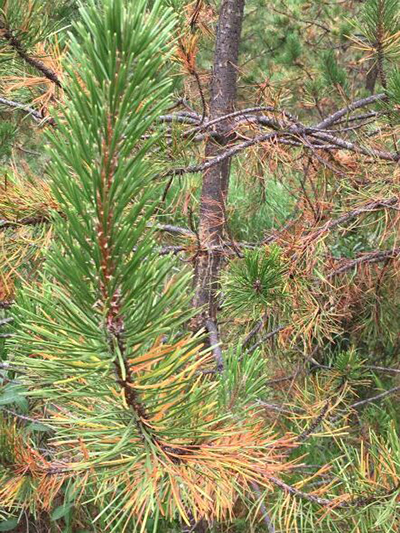 Young needle green Young needle green | 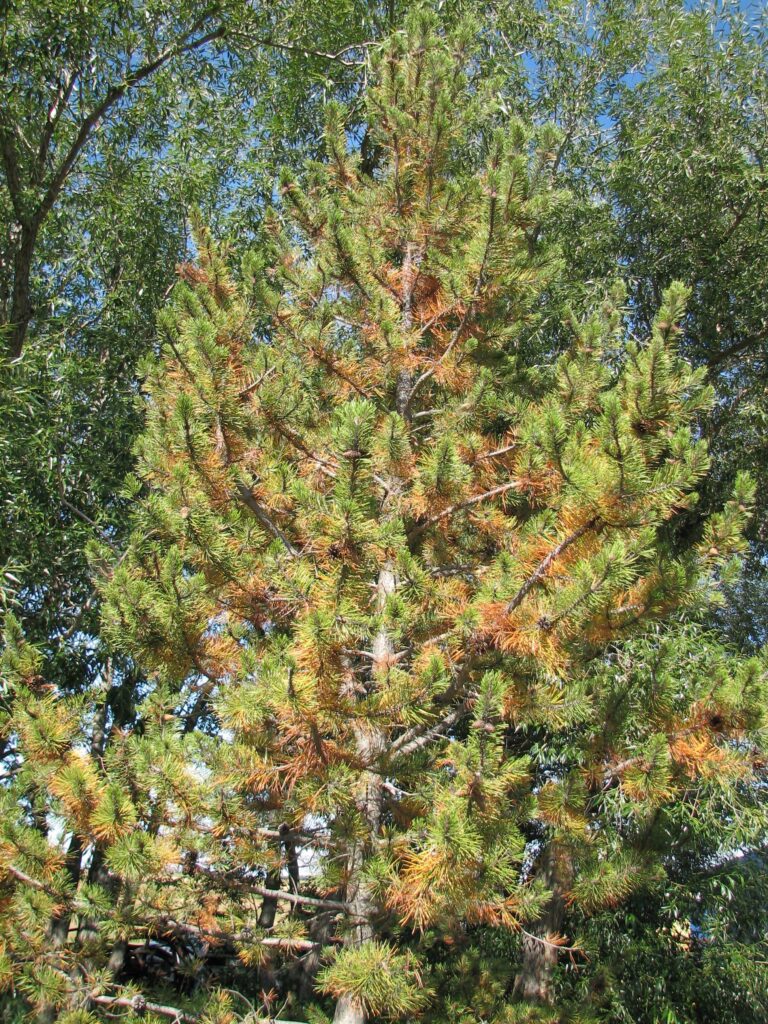 Closer to trunk Closer to trunk |
Reasons for fall needle drop
The process of fall needle drop is regulated by various environmental cues and internal hormonal and cellular changes within the tree. These cues include changes in daylight duration, temperature, and soil moisture levels. The most common causes of excessive needle drop are too wet and too dry soils.
As the days shorten and temperatures drop, the tree begins preparing for winter, coniferous trees optimize their resources by shedding older needles. These needles have lower photosynthetic activity compared to newer ones and shedding them helps conserve energy and nutrients.
Shedding older needles further reduces water loss, aiding the tree in surviving the drier conditions often associated with the fall season. Lastly, older needles are more susceptible to diseases and infestations by pests. Shedding them helps the tree maintain its overall health and reduces the risk of infections that could harm the entire tree.
Benefits of fall needle drop
The fall needle drop has important several ecological benefits such as nutrient recycling, providing wildlife habitat, and reducing soil erosion. The needles that fall to the ground serve as a source of nutrients for the soil. Over time, these needles decompose, releasing valuable nutrients that enrich the soil and promote the growth of other plants in the ecosystem.
The fallen needles create a layer of organic material on the forest floor, providing habitat and protection for a variety of insects, fungi, and small organisms. This layer also supports the growth of understory plants that serve as food for many forest-dwelling creatures. The layer of needles on the forest floor helps reduce soil erosion by acting as a natural mulch. It protects the soil from the impact of heavy rain and promotes moisture retention.
Conclusion
Landowners don’t need to be alarmed about the fall needle drop as it is a natural and essential process for coniferous trees. There is no harm to trees during the fall needle drop. Trees are just ensuring their adaptation to changing environmental conditions and promoting the overall health of the forest ecosystem. Understanding the symptoms of fall needle drop is crucial for tree owners, foresters, horticulturalists, and arborists to differentiate this natural process from potential tree health concerns.
Fall Planting Caliper Trees
Fall is an excellent time to plant larger caliper trees on your property. A “caliper tree” refers to a more mature tree with a stem diameter of at least 4 cm measured 15 cm above ground. Larger caliper trees typically have a stem diameter of around 10 cm, measured 30 cm above ground. In Alberta, early fall offers ideal conditions for tree planting, as moisture levels are higher than in summer, giving new trees the best chance to establish their root systems before winter sets in. Proper planting techniques are essential to reduce transplant shock and ensure tree health. Below are key steps to consider when planting caliper trees.
Tree Species Selection
Diversity is essential for the health and resilience of your landscape. Alberta has a variety of both native and ornamental tree and shrub species that thrive despite the province’s harsh climate. Ornamental species can add beauty and complement native species in your landscape. Several online tools can help you select trees and shrubs suited to your property’s specific conditions. Visit local parks, arboretums, or nurseries for inspiration and consult with local horticulturists or arborists to determine which species will perform well in your area.
Selecting the Planting Site
Selecting the right planting site is vital for long-term tree health. Consider factors such as soil type, moisture levels, slope, sun exposure, and proximity to buildings or power lines. It’s helpful to observe mature trees of the species you’re considering to understand how much space they require at full size. This foresight helps prevent potential conflicts with structures or utilities as the tree grows.
Choosing Planting Stock
Caliper trees are available in containers or as balled and burlap (B&B) stock.
- Container Stock: Inspect container-grown trees for broken branches, signs of disease or insects, weak branch angles, and root-bound conditions (visible roots protruding from the container). A bound root system can cause future issues; avoid purchasing trees with excessively circling roots or other root deformations.
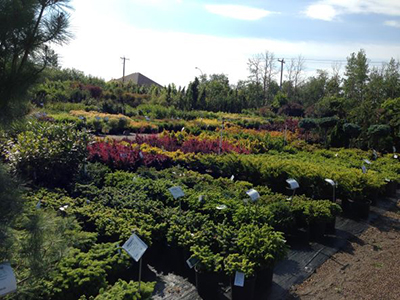 Containerized shrubs | 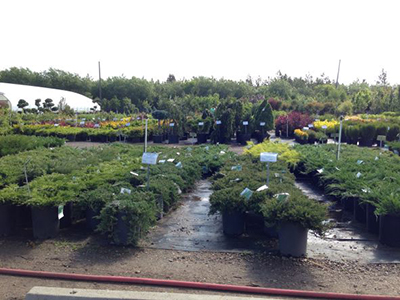 Contatiner stock | 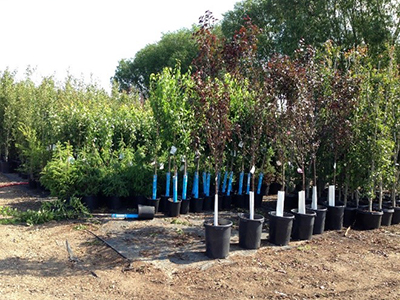 Potted stock |
- Balled and Burlap (B&B) Stock: Typically, larger-caliper trees come balled in a wire basket and wrapped in burlap. Before purchase, inspect the overall health of the tree.
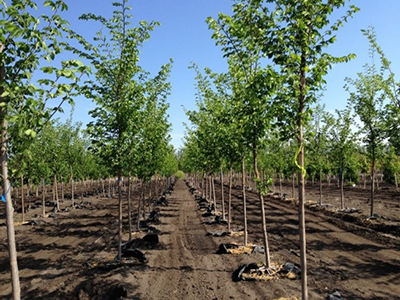 In the field | 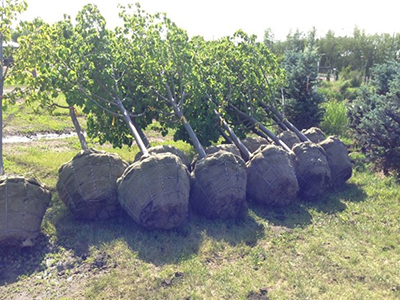 Ready to transport | 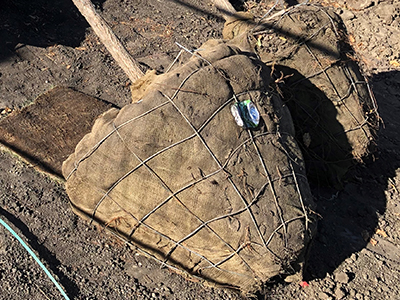 Burlap and wired basket |
Planting
Proper planting techniques are crucial for tree survival. For container stock, carefully remove the soil around the root ball by shaking or rinsing it off, exposing any problematic roots. Address any circling, girdling, or hooked roots by pruning them as needed.
Tree Planting Hole Size: Dig a hole as deep as the root ball but two to three times wider. This wider hole facilitates lateral root growth. For B&B trees, fit the root ball into the hole, then remove the burlap and wire basket from the upper portion before backfilling with soil.
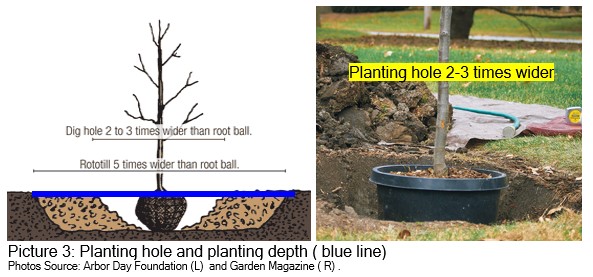
Tree Planting Depth: Ensure the root collar (where roots meet the trunk) is slightly above ground level. Planting too deep can lead to root suffocation and rot.
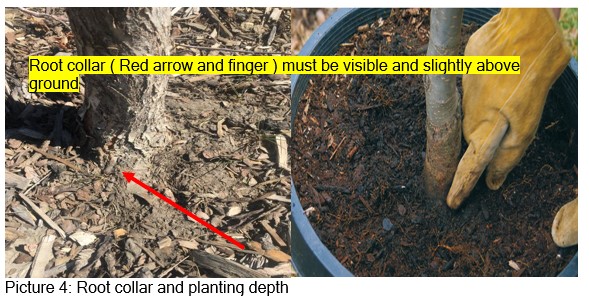
Backfilling: Avoid adding soil amendments unless the soil is extremely poor. In that case, mix no more than 10% of high-quality soil with the native soil. Pack the backfill firmly to eliminate air pockets.
Watering: Water thoroughly after planting and again three days later. Keep the soil consistently moist but not waterlogged. A simple test: if a screwdriver can easily penetrate the soil to a depth of six inches, moisture levels are sufficient. Drip irrigation is a long-term solution for watering trees, as turf irrigation often does not provide adequate deep watering.
Staking: Smaller trees or those in protected areas typically do not need staking. However, in windy areas, tall or top-heavy trees may require staking. Remember to remove stakes after a couple of years to avoid damaging the tree.
Mulching
Apply mulch around the tree in a donut-shaped ring, keeping it away from the trunk. Mulching prevents weeds, protects roots from temperature extremes, and retains soil moisture. Additionally, mulch can insulate roots from freezing during winter, reducing the risk of damage and improving tree survival.
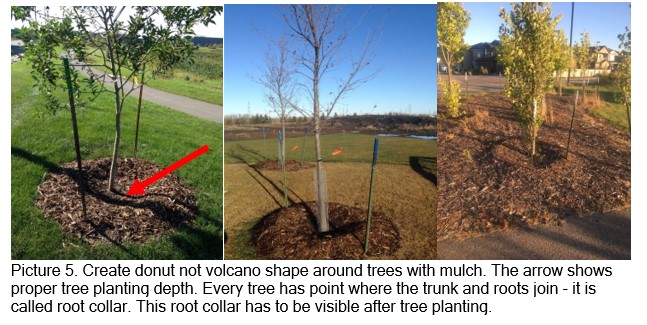
Fertilization
Avoid fertilizing trees during fall planting unless addressing a nutrient deficiency in particularly poor soils. Refrain from fertilizing any trees or shrubs after mid-July to allow them to harden off before winter.
By following these guidelines, you can give your newly planted caliper trees the best chance for a healthy start and successful establishment on your property.
